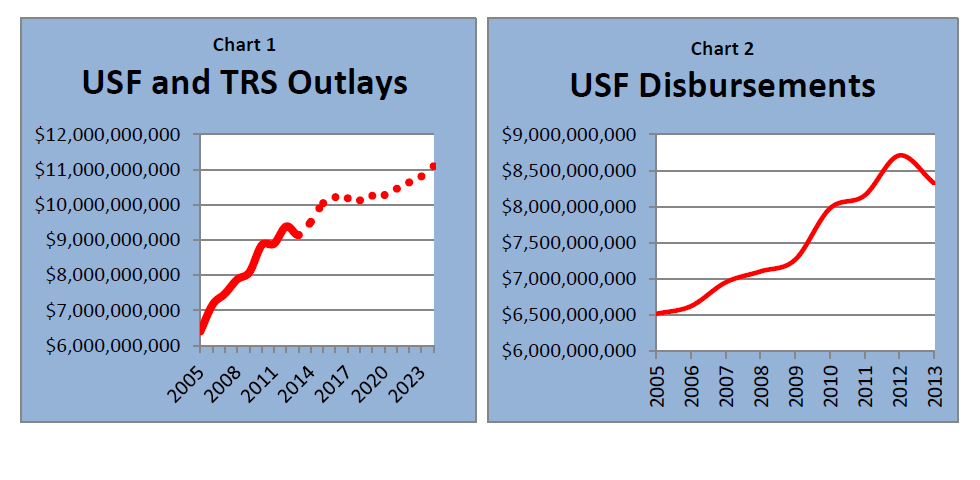
Chart 1 shows the FCC’s actual outlays for the Universal Service Fund (USF) and Interstate Telecommunications Relay Services Fund (TRS) to date and the future spending projections through the year 2024 as estimated by the Congressional Budget Office (CBO), our nation’s official budgetary scorekeeper. Chart 2 shows the growth in USF disbursements, which have been the primary driver of the growth seen in Chart 1.[1]
Under the current structure, the programs are scheduled to grow to $10 billion in 2015 and steadily increase thereafter to reach $11 billion in 2024. Most of that growth will continue to be attributable to USF.[2] This means that in 2024, the funds will be over 21% larger than they were in 2013 and, in those 11 years, the funds will spend a remarkable $13 billion more than they would have if funding had been kept at 2013 levels. Importantly, this trajectory just represents present circumstances. In other words, it does not assume that the Commission will make any programmatic changes that would further increase spending.
In fairness, USF’s past growth should not be too surprising for close followers. It is a culmination of various past Commission decisions that have had the effect of increasing the overall size of the Fund. For example, to make explicit some of the former implicit subsidies necessary to ensure continued communications service in high-cost areas, the Commission phased out certain intercarrier compensation (ICC) charges over time and replaced them, in part, with new USF funding. Meanwhile, the Fund grew dramatically after the Commission allowed multiple providers to obtain high-cost funding in the same areas (a policy that ended after 2011) and again when the agency added wireless phones to USF’s Lifeline program.
So what do CBO’s USF projections mean for the average American? They represent an ever growing strain on their pocketbook. That is because the FCC—through an entity called the Universal Service Administrative Company (USAC)—simply estimates what will be needed to cover the planned expenditures for the USF programs, assesses telecom providers, and this cost is inevitably passed on to consumers in the form of a fee on their phone bills.[3] Given the fund’s projected growth, we must be increasingly sensitive to the burdens that this fee creates and strive to limit the amount of any increase.
That is why I am concerned about the budget aspect of the upcoming reforms to the E-Rate program. To be clear, I fully support modernizing E-Rate to reflect the current needs of students in the 21st Century. For too long, the Commission has funded functions that no longer make sense (e.g., long distance phone service and paging) which has detracted from funding the broadband needs of schools and libraries. Meanwhile, many educational entities seeking needed E-Rate dollars are often deterred by unnecessary hurdles in the current system, which should be streamlined. Finally, we should greatly improve transparency and do far more to prevent waste, fraud and abuse so that all E-Rate dollars go toward benefitting students and library patrons.
The solution to any E-Rate problems, however, cannot simply be a blanket call to further increase overall USF spending. Doing so would only exacerbate the spending increases already anticipated. If we believe that more E-Rate spending is necessary now or in the future, then we should make the firm commitment at this moment to stabilize USF by agreeing to offset this new spending by reducing spending elsewhere. It will be very tempting to take the easy route today and leave the difficult funding consequences to a future Commission. But, that would not be real leadership or good stewardship of the American people’s trust. Instead, I hope that we will use this opportunity to make the responsible decision to live within a reasonable but limited budget, just as American families do every day.
[1] See FCC, Universal Service Monitoring Report, at Table 1.12 (Dec. 2013), https://transition.fcc.gov/Bureaus/Common_Carrier/Reports/FCC-State_Link/Monitor/2013_Monitoring_Report.pdf; USAC, 2013 Annual Report, at 35 (last visited July 7, 2014), http://usac.org/_res/documents/about/pdf/annual-reports/usac-annual-report-Interactive-Layout-2013.pdf.
[2] TRS now accounts for approximately $800 million and is subject to certain inflation and efficiency adjustments. See Telecommunications Relay Services and Speech-to-Speech Services for Individuals with Hearing and Speech Disabilities, Structure and Practices of the Video Relay Service Program, CG Docket Nos. 03-123, 10-51, Order, DA 14-946 (CGB rel. June 30, 2014).
[3] Similarly, the TRS administrator estimates the funding requirements for TRS based on proposed compensation rates for the TRS programs and the projected administration expenses. Consumers ultimately pay an additional fee on their phone bills.